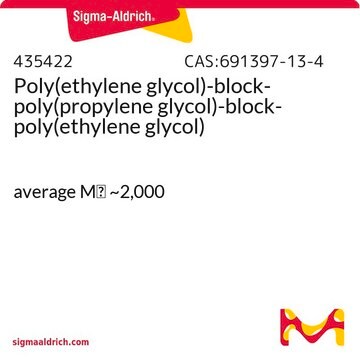If this product has an expiration or retest date, it will be shown on the Certificate of Analysis (COA, CofA). If there is no retest or expiration date listed on the product's COA, we do not have suitable stability data to determine a shelf life. For these products, the only date on the COA will be the release date; a retest, expiration, or use-by-date will not be displayed.
For all products, we recommend handling per defined conditions as printed in our product literature and website product descriptions. We recommend that products should be routinely inspected by customers to ensure they perform as expected.
For products without retest or expiration dates, our standard warranty of 1 year from the date of shipment is applicable.
For more information, please refer to the Product Dating Information document: https://www.sigmaaldrich.com/deepweb/assets/sigmaaldrich/marketing/global/documents/449/386/product-dating-information-mk.pdf
435503
Poly(propylene glycol)-block-poly(ethylene glycol)-block-poly(propylene glycol)
average Mn ~3,300
Synonym(s):
Pluronic® 31R1, PPG-PEG-PPG
About This Item
Recommended Products
form
viscous liquid
mol wt
average Mn ~3,300
composition
PEG, 10 wt. %
refractive index
n20/D 1.454
surface tension
34 dyn/cm, 25 °C, 0.1 wt. % in H2O
viscosity
660 cP(25 °C, Brookfield)(lit.)
transition temp
softening point −25 °C
cloud point 25 °C (1 wt. % aqueous solution)
density
1.018 g/mL at 25 °C
HLB
2.0 - 7.0
SMILES string
O2C(C2)C.O1CC1
InChI
1S/C3H6O.C2H4O/c1-3-2-4-3;1-2-3-1/h3H,2H2,1H3;1-2H2
InChI key
RVGRUAULSDPKGF-UHFFFAOYSA-N
General description
Application
Features and Benefits
Legal Information
Storage Class Code
10 - Combustible liquids
WGK
WGK 3
Flash Point(F)
Not applicable
Flash Point(C)
Not applicable
Choose from one of the most recent versions:
Already Own This Product?
Find documentation for the products that you have recently purchased in the Document Library.
Customers Also Viewed
Articles
Mesoporous materials self-assemble from sol-gel precursors and amphiphiles, forming versatile structures for various applications.
Mesoporous materials self-assemble from sol-gel precursors and amphiphiles, forming versatile structures for various applications.
Mesoporous materials self-assemble from sol-gel precursors and amphiphiles, forming versatile structures for various applications.
Mesoporous materials self-assemble from sol-gel precursors and amphiphiles, forming versatile structures for various applications.
-
How can I determine the shelf life / expiration / retest date of this product?
1 answer-
Helpful?
-
-
How is shipping temperature determined? And how is it related to the product storage temperature?
1 answer-
Products may be shipped at a different temperature than the recommended long-term storage temperature. If the product quality is sensitive to short-term exposure to conditions other than the recommended long-term storage, it will be shipped on wet or dry-ice. If the product quality is NOT affected by short-term exposure to conditions other than the recommended long-term storage, it will be shipped at ambient temperature. As shipping routes are configured for minimum transit times, shipping at ambient temperature helps control shipping costs for our customers. For more information, please refer to the Storage and Transport Conditions document: https://www.sigmaaldrich.com/deepweb/assets/sigmaaldrich/marketing/global/documents/316/622/storage-transport-conditions-mk.pdf
Helpful?
-
Active Filters
Our team of scientists has experience in all areas of research including Life Science, Material Science, Chemical Synthesis, Chromatography, Analytical and many others.
Contact Technical Service







